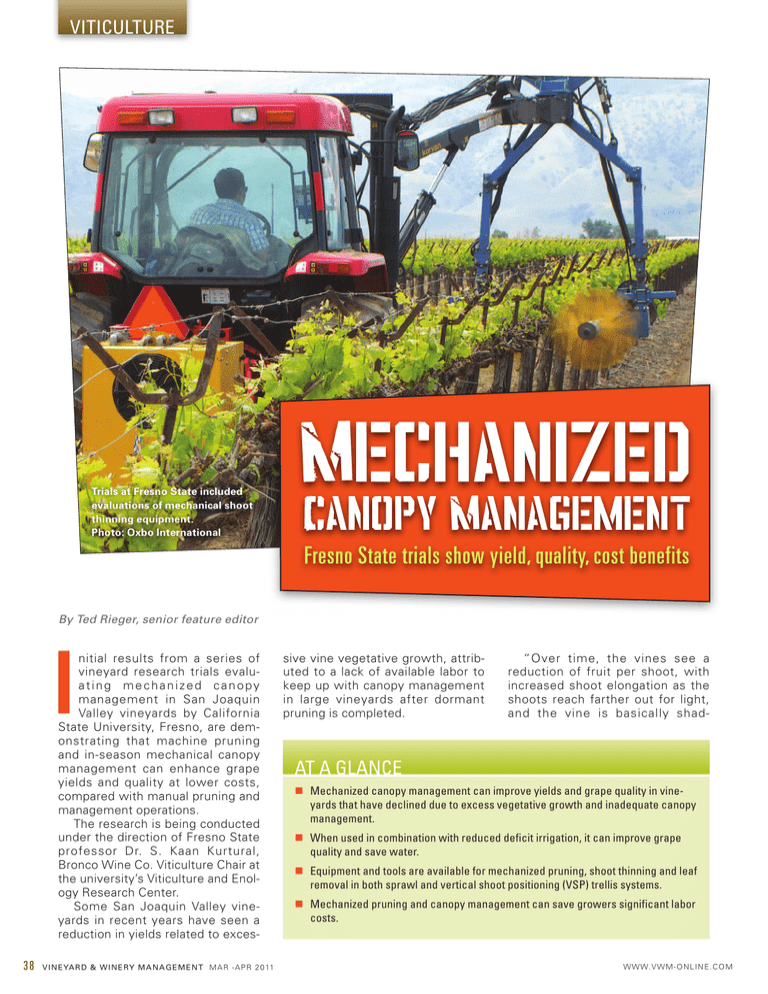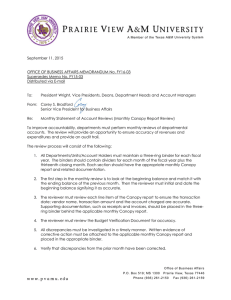Mechanized Canopy Management VITICULTURE
advertisement

VITICULTURE Trials at Fresno State included evaluations of mechanical shoot thinning equipment. Photo: Oxbo International Mechanized Canopy Management Fresno State trials show yield, quality, cost benefits By Ted Rieger, senior feature editor nitial results from a series of vineyard research trials evaluating mechanized canopy management in San Joaquin Valley vineyards by California State University, Fresno, are demonstrating that machine pruning and in-season mechanical canopy management can enhance grape yields and quality at lower costs, compared with manual pruning and management operations. The research is being conducted under the direction of Fresno State professor Dr. S. Kaan Kurtural, Bronco Wine Co. Viticulture Chair at the university’s Viticulture and Enology Research Center. Some San Joaquin Valley vineyards in recent years have seen a reduction in yields related to exces- 38 V I N E YA R D & WINERY MANAGEMENT MAR -APR 2011 sive vine vegetative growth, attributed to a lack of available labor to keep up with canopy management in large vineyards after dormant pruning is completed. “Over time, the vines see a reduction of fruit per shoot, with increased shoot elongation as the shoots reach farther out for light, and the vine is basically shad- AT A GLANCE Mechanized canopy management can improve yields and grape quality in vineyards that have declined due to excess vegetative growth and inadequate canopy management. When used in combination with reduced deficit irrigation, it can improve grape quality and save water. Equipment and tools are available for mechanized pruning, shoot thinning and leaf removal in both sprawl and vertical shoot positioning (VSP) trellis systems. Mechanized pruning and canopy management can save growers significant labor costs. W W W. V W M - O N L I N E . C O M VITICULTURE ing itself out,” Kurtural said. If the canopy is not managed, and normal irrigation and nutritional inputs are continued, he said, it can exacerbate the problem of excess vegetative growth. In some vineyards, yields have declined from 12-13 tons per acre to 3-4 tons per acre over five years. Excess vegetation and improper vine balance also affect fruit quality. Kurtural is working with viticulturist Greg Berg of Oxbo International in nearby Kingsburg, Calif. Oxbo is providing Korvan vineyard equipment and tools, and Berg has been working with Fresno State researchers to operate, evaluate, adapt and demonstrate the equipment as a partner in the trials. The research is also supported by the American Vineyard Foundation, Bronco and West Coast Grape Farming. The trials also provide research and practical experience for 10 Fresno State students each year in vineyard and equipment operations, sampling, lab analysis and winemaking. Research has focused on vineyards with California sprawl trellis systems, typical in the Central Valley. To date, the dormant-season mechanized pruning utilized in each trial has been a tight box pruning with a 4-inch hedge of spurs. Kurtural said other feasible in-season operations that could be mechanized in San Joaquin Valley vineyards are shoot thinning, leaf removal and cluster thinning. Varieties being evaluated in the trials are syrah and pinot gris, which produce quality wines in the San Joaquin Valley and with potentially higher demand and value compared to other varieties (the wines are labeled as shiraz and pinot grigio). TOOLS AND EQUIPMENT Berg said mechanized canopy management has been accepted and is used more routinely in Central Coast vineyards than in Central Valley vineyards. Explaining some of the reasons for Oxbo’s participation in the research trials, Berg said, “Part of the resistance growW W W. V W M-ONLINE.COM ers have to increasing mechanization is that they are afraid they will mess up their vines. We’re trying to bring best management practices to the vineyard and show that the technology works.” and Berg said he believes mechanized pruning and canopy management can be done with more uniformity and consistency than hand operations in order to achieve balanced cropping. A Korvan Cordon Brush can remove unwanted shoots from vines in early spring. Photo: Ted Rieger He noted that mechanical grape harvesting has led the way in vineyard mechanization and is now accepted. Now it’s time for other vineyard operations to be done mechanically. Labor costs and availability already favor mechanization, “Leaf area, shoot density, cluster numbers, we can affect all of those things,” he explained. “It’s just a matter of what’s the best recipe for grape and wine quality in relation to yield for each vineyard site.” Berg said that it’s generally DOUBLE A VINEYARDS, INC. GROWERS OF QUALITY GRAPEVINES We grow a full line of American, Hybrid, Vinifera and Seedless grapevines. Call for our catalog or to place an order today. also carry Blue-X vine shelters. Call for a sample. We now Currently taking orders for the Spring of 2011. phone: (716) 672-8493 e-mail: suerak@rakgrape.com fax: (716) 679-3442 website: www.doubleavineyards.com M A R - A P R 2 0 11 V I N E YA R D & W I N E RY M A N A G E M E N T 39 VITICULTURE better to wait until a vineyard is 5-6 years old before doing mechanized canopy management. Oxbo manufactures canopy management tools under the Korvan brand for both VSP trellis systems (common in coastal vineyards) and for California sprawl systems. Three types of Korvan tool carriers, which attach and interchange management tools to the vineyard tractor, are available in one- and two-row configurations. The following Korvan tools are being used in the Fresno State canopy management trials, interchanged and mounted on a tractor with a single-row 1210 Tool Carrier: A sprawl pruner, designed for California sprawl systems with crossarms up to 24 inches, performs dormant-season pruning. It has height-adjustable rotary side cutter heads for precision box pruning, and vertical shear bars in front that first cut off longer canes that stick out between rows. Cordon brushes have heads that are rotating rollers with 150 urethane cords (each about 10-12 inches long) designed for mechanical removal of unwanted shoots from cordon-trained vines. They are most commonly used to remove shoots below the cordon, in place of hand suckering, but can also be run a bit higher into the fruiting zone to remove a few cluster bearing shoots, if lower crop yields are desired. Berg said the ideal time to use the cordon brush is early spring, when the vines have 6-10 inches of shoot growth. The cordon brush can also be used to remove suckers from the base and trunk of the vine. ing drum that draws in air and leaves that are sheared from the vine with a sickle bar. Berg said not much leaf removal is done mechanically in Central Valley vineyards, so he adapted the deleafer for the research trials by attaching a bow rod in front of the unit to lift canes up and away from the fruiting zone, thus providing access. The leaf remover is used starting in late spring, after berry set and before veraison, to assist with air circulation and light penetration to the fruiting zone. A leaf remover has a rotat- Korvan’s de-leafer can remove leaves from the vine fruiting zone. Photo: Ted Rieger All three tools are being used in Fresno State’s trials with syrah and pinot gris in Arvin, in Kern County. The sprawl pruner and the cordon brush are being used in a syrah/ shiraz trial in Chowchilla, in Madera County. CHOWCHILLA TRIALS Current studies include trials in a 36-acre syrah vineyard in Chowchilla, planted in 1997. Trials began in 2009 and will continue through 2011. Four canopy treatments and levels have been compared: Hand-pruning dormant vines to 40 V I N E YA R D & WINERY MANAGEMENT MAR -APR 2011 W W W. V W M - O N L I N E . C O M VITICULTURE 21 spurs with two nodes each (control) Observed Kurtural, “With mechanized canopy management, we could reduce the number of leaf layers from seven to 3.5, so the canopy is still providing shade, but we’re also improving the light penetration into the fruiting zone.” The crop load low and crop load Ad Art2011BFINAL.pdf 1/31/11 mid treatments reduced leaf layer Mechanically pruning to 4-inch hedges, and mechanically thinning shoot and cluster density to five shoots per foot of row and nine clusters per foot (the crop load low treatment) Seven shoots per foot of row and 15 clusters per foot (crop load mid) Fifteen shoots per foot of row and 17 clusters per foot (crop load high) A trial was also done in the same vineyard in conjunction with reduced deficit irrigation (RDI), with varying severity and timing using the same four canopy treatment levels above. Control vines were irrigated to 70% evapotranspiration (ET) until harvest (control). Other vines either received 70% of full-vine ET up to veraison, after which the irrigation rate was cut to 50% (RDI late), or had a treatment with irrigation cut to 50% before veraison, RDI early, but not thereafter. Wines were made from each treatment at Bronco’s Cottonwood Creek facility in Madera. Kurtural and Fresno State graduate student researcher Dave Terry summarized the trial results to date. Using the canopy management methods that show the best overall results, growers can set the count shoots 5.0 cm apart along the cordon with mechanical thinning that will result in three to four leaf layers by immediate pre-veraison. A leaf area of 11.9 square meters per vine proves to be sufficient to ripen the 11-tons-per-acre crop to the target of 23 °Brix. Syrah berry size was reduced with mechanical canopy management without adversely affecting yield, as enough clusters were present to ensure sufficient yield. In the first year of the experiment, the reduction in berry size positively affected the skin-to-pulp ratio, with elevated levels of anthocyanins, tannins and total phenols in the finished wines. numbers by 50% compared to the control. The early and late RDI also reduced leaf layer numbers by 22% and 10%, respectively, compared with the control. The results showed an interaction of canopy management and RDI stress on wine total phenolics, 12:01:45 PM tannins and anthocyanins, with the • Powdery Mildew? JMS Stylet-Oil® - The Choice • Mites? For Powdery Mildew and Mite control, grape growers choice: have a JMS Stylet-Oil JMS offers grape growers an effective alternative to early-season sulfur treatment. C M Y CM MY CY CMY • Outperforms sulfur as an eradicant on powdery mildew - University researched and rated 10/10. • JMS Stylet-Oil is a stand-alone product for powdery mildew. • Eliminates early season inoculum growth that can cause late-season epidemics. • Unlike sulfur, JMS Stylet-Oil works well in cool weather, protects around the clock, and harmlessly degrades without potential air pollution. K W W W. V W M-ONLINE.COM Apply this clean white oil early for mite control throughout the season. JMS Stylet-Oil is now available in its conventional formulation or an organic formulation that is OMRI listed for use in an organic program. Contact JMS for complete information and product data. Headquarters Pacific Northwest Region 4423 5th Place SW 73585 Williams Lane Vero Beach, FL 32968 Pendleton, OR 97801 Office: (772) 562-8770 Office: (541) 276-8566 Fax: (772) 562-7202 Fax: (541) 276-6245 styletoil@aol.com styletoil@eoni.com www.stylet-oil.com M A R - A P R 2 0 11 V I N E YA R D & W I N E RY M A N A G E M E N T 41 VITICULTURE crop load low treatment and late RDI having the highest tannins and total phenolics. The highest wine anthocyanins were with the crop load mid and early RDI. Kurtural summarized, “When mechanized canopy management is combined with RDI stress, it reduces berry size, but we believe we can maintain yields of 11 tons an acre reliably, year after year, with a 15% savings in irrigation water, while also improving color and phenolics.” SYRAH AND PINOT GRIS TRIALS Trials to evaluate mechanized canopy management in 80-acre commercial syrah and pinot gris vineyards in Arvin began in 2010 and will continue through 2012. This southern San Joaquin Valley location is subject to high summer heat and experiences vigorous canopy growth. It appears that light and temperature availability within canopies is affecting flower induction where shading during late spring is reducing development and fruitfulness of latent buds in this location. Both the syrah and the pinot gris vines were dormant-pruned the third week of February, with the hand-pruned vines spur-pruned Adjustments were made in the vineyard to the shoot thinning equipment to improve performance. Photo: S. Kaan Kurtural, Fresno State to retain 22 nodes on 11 spurs per vine, and the machine-pruned vines box-pruned to a 4-inch hedge of spurs. The mechanized management was done the second week in April, with three different shoot-thinning treatments of seven shoots per row of vine (low), 10 shoots per row of vine (medium) and 15 shoots per row of vine. In addition to mechanical prun- ing and shoot thinning, trials were done with and without mechanical leaf thinning that was performed on the east (morning sun exposure) side of rows during the second week in June, to evaluate as a treatment option. Based on initial results, Kurtural said mechanical pruning alone helped provide better overall yields. In the syrah vineyard, yields had Weed Badger® 3875 Mower Get great savings now on early season in-row management tools. Till weeds, mow cover crops, hill-up, hilldown, sweep...all with one machine! Call and ask for a factor y-direct quote! 8 0 0 - 4 3 7 - 3 3 9 2 • w w w. w e e d b a d g e r. c o m 42 V I N E YA R D & WINERY MANAGEMENT MAR -APR 2011 W W W. V W M - O N L I N E . C O M VITICULTURE declined to 2.5-4 tons per acre. After just one season of mechanized canopy management, yields soared to 8 tons per acre with some of the treatments. Declining yields had not become an issue for pinot gris in the Arvin vineyards, where yields averaged 10-11 tons before and after the trials started. The syrah had better berry set, with smaller berries and improved cluster architecture with mechanical canopy management. The medium shoot-thinning treatment resulted in the best color and phenolic composition for the syrah. Leaf thinning did not impact berry weights or influence yields, but it did improve light penetration in the fruiting zone, with up to 30% more light. Kurtural said the pinot gris had the best wine chemical composition with leaf thinning treatments. Based on results to date, Kurtural also observed, “Knowing the W W W. V W M-ONLINE.COM proper shoot density helps us predict the number of leaf layers, and we think there is a better relationship between leaf layers and final yields. So leaf layers may be a better predictor of yields than cluster counts.” The trials will continue through 2012, with the goal of identifying sustainable canopy management methods that positively affect bud microclimate and fruitfulness, canopy microclimate, cluster architecture, yield components, and fruit and wine composition. COST COMPARISON Kurtural and Berg worked together on a recently completed trial with research associate Geoffrey Dervishian, studying the effects and economics of hand pruning vs. mechanical pruning in a cabernet sauvignon vineyard on the Fresno State campus. The three treatments used were hand dormant-pruned vines retaining 32-40 buds per vine, with no further canopy management; mechanically box-pruned vines that were then hand-thinned to a density of 10 shoots per meter of cordon, and mechanically boxpruned vines that were mechanically shoot-thinned to 19 shoots per meter of cordon. Comparing results from the three treatments showed better shoot exposure with the full mechanical treatment, but no significant differences in yield, and mostly incremental differences in other parameters such as juice and must chemistry. A significant difference was seen in labor savings with the mechanically pruned/mechanically thinned vines saving 42% over the hand-pruned vines, and 31% over the mechanically pruned/handthinned vines. Stated in cost figures, mechanical pruning/mechanical thinning could be done at a cost of 29 cents per vine, compared with hand pruning at 50 cents per vine. Kurtural concluded, “By completely mechanizing the operations, we can prune and adjust shoot numbers and it cuts down on costs, so we know it’s economically viable.” The above costs are based on a vineyard management company performing the mechanical operations, rather than the cost of purchasing and operating equipment. Berg created a computer-generated calculator to compare machine costs with per-hour labor costs for growers buying or leasing their own equipment, based on vineyard acreage and other factors. The purchase price for a Korvan 1210 tool carrier, a sprawl pruner and a cordon brush would total about $56,000. Based on Berg’s calculations for a 240-acre vineyard as an example, mechanical operations would save $102,000 per year in labor costs, so payback on the equipment purchase would be less than one year. FUTURE RESEARCH OBJECTIVES Kurtural said additional research will look at mechanical canopy management in separated or two-plane canopy trellis systems, such as divided canopy systems, in addition to single-plane systems, such as sprawl. Kurtural said he hopes to look at the relationship between mechanical management and vine nutrition on chemical components such as sodium, calcium, phosphorous, zinc and boron, in order to provide recommendations on levels of nutrients to return to the vineyard to sustain vines managed by mechanical means. Kurtural also plans to work with Fresno State colleague Dr. Susan Rodriguez, manager of the Sensory Evaluation Laboratory, to conduct consumer tasting evaluations of wines from the trials, to evaluate preferences and ask tasters what they would be willing to pay for the wines. Ted Rieger, CSW, is a writer and photographer based in Sacramento, Calif., and has been a contributing editor for V&WM since 1990. Comments? Please e-mail us at feedback@vwm-online.com. M A R - A P R 2 0 11 V I N E YA R D & W I N E RY M A N A G E M E N T 43




